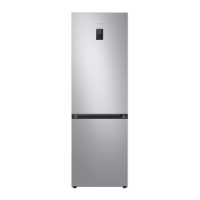Why is my Samsung RB3 T too cold?
- OomaloneAug 27, 2025
If your Samsung Fridge/Freezer is over-cooling, the temperature control may not be set correctly. Try setting the temperature higher.

Why is my Samsung RB3 T too cold?
If your Samsung Fridge/Freezer is over-cooling, the temperature control may not be set correctly. Try setting the temperature higher.
Why is my Samsung RB3 T not cooling properly?
If your Samsung Refrigerator is not operating or the temperature is too warm, several factors could be the cause. First, ensure the power cord is properly plugged in. Check that the temperature control is set correctly; you may need to set it lower. Also, the refrigerator should not be near a heat source or in direct sunlight. Ensure there's enough clearance (at least 5 cm) between the refrigerator and the walls. Deactivate the Vacation function if it's on. Avoid overloading the refrigerator and ensure food isn't blocking the vents.
Why is my Samsung Refrigerator not cold enough?
Your Samsung Refrigerator might not be cooling properly due to several reasons. Ensure the power cord is correctly plugged in. The temperature control may not be set low enough, so adjust it accordingly. The refrigerator should be away from heat sources and direct sunlight, with at least 5 cm of clearance on the sides and rear. Also, check if the Vacation function is activated and deactivate it. Avoid overloading the refrigerator and ensure food isn't blocking the vents.
What to do if there is frost on the interior walls of Samsung RB3 T Refrigerator?
If you notice frost on the interior walls of your Samsung Refrigerator, it's likely that the door isn't closing properly. Make sure food isn't blocking the door and clean the door gasket to ensure a proper seal.
| Refrigerant | R600a |
|---|---|
| Reversible Door | Yes |
| Egg Container(Egg Tray) | Yes |
| Number of Door Bins / Door Shelves | 3 |
| Wine Rack | No |
| Number of Vegetable&Fruit Drawer | 1 |
Key information and warnings for safe appliance operation, installation, and maintenance.
Explanation of warning, caution, and note symbols used in the manual for user safety.
Critical safety guidelines related to electrical hazards, flammable materials, and proper appliance use.
Recommendations to minimize energy consumption by optimizing appliance placement and usage.
Warnings and precautions for safely transporting and positioning the refrigerator.
Essential safety measures for installing the refrigerator to prevent electrical hazards and damage.
Precautions to take during installation, including proper grounding and surface requirements.
Essential warnings for safe daily operation, covering door usage, internal storage, and child safety.
Guidelines for proper and safe food storage, handling, and appliance use.
Safety precautions and methods for cleaning the refrigerator, avoiding damage and electrical hazards.
Important warnings regarding the safe and environmentally friendly disposal of the refrigerator.
Advice for optimal refrigerator performance and longevity, including power failure procedures.
Guidelines for the correct disposal of Waste Electrical and Electronic Equipment (WEEE).
Diagram and identification of refrigerator parts for different models.
Detailed instructions for installing the refrigerator, starting with site selection.
Specifications for necessary space around the refrigerator for proper ventilation and door operation.
Instructions on using spacers for ventilation and preparing the floor for refrigerator placement.
Procedure for levelling the refrigerator using the adjustable front legs.
Steps for initial setup, temperature alarm function, and final installation verification.
Explanation of the refrigerator's control panel indicators, buttons, and network connection.
Guide to adjusting fridge and freezer temperatures, including Power Cool and Vacation modes.
Details on available freezer modes like Power Freeze, Soft Freeze, and Chill, with cautions.
Instructions for turning the Wi-Fi function on or off for smart connectivity.
How to use the dial control for setting fridge and freezer temperatures, including seasonal recommendations.
Using the Vacation mode for extended absences to maintain optimal conditions.
Steps to download and install the SmartThings app for refrigerator control.
Registering a Samsung account and using the SmartThings app for remote refrigerator management.
Summary of monitoring, functions, alarms, and AI saving mode available through the SmartThings app.
Instructions for filling and using the refrigerator's water dispenser.
Using the Optimal Fresh+ drawer with Flex Divider and adjusting Humidity Fresh+ settings.
Instructions on how to install and use the optional freezer shelf for increased space.
Step-by-step guide to changing the direction of the door handles on models with bar handles.
Detailed instructions and required tools for reversing the refrigerator doors.
Identification of accessory parts related to door reversal and maintenance.
Comprehensive steps for removing and reattaching refrigerator doors for reversal.
Guidelines for safely cleaning the refrigerator's interior and exterior surfaces.
Instructions for cleaning the rear panel or compressor cover, with a safety warning.
Information on replacing LED lamps and door panels, including service center recommendations.
Instructions for installing two refrigerators side-by-side, including kit requirements.
List of tools and specific accessories required for connecting two refrigerators.
Detailed steps for aligning, securing, and installing two refrigerators together.
Diagnosing and resolving common temperature problems like not operating or being too warm/cold.
Solutions for refrigerator odors, frost around vents, and excessive frost build-up.
Tips for managing condensation formation on interior walls due to door opening or moisture content.
Explanation of normal operating sounds like clicking, buzzing, whirring, and sizzling.
Resolving issues with finding, operating, connecting, or logging into the SmartThings app.
Energy efficiency tips and guidelines for appliance placement based on climate class.
Recommended temperature settings and tips for optimal food preservation.
Detailed charts for refrigerator and freezer storage longevity of milk products and meats.
Storage longevity charts for poultry, eggs, fish, seafood, fruits, and vegetables.
Information on accessing model registration, spare parts availability, and repair resources.